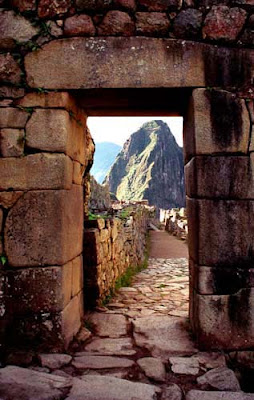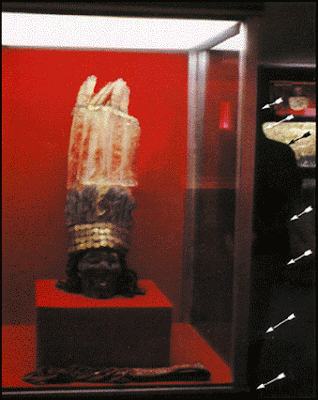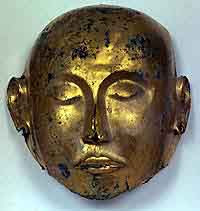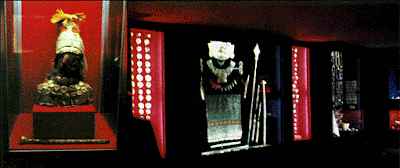
Second mummified head of a giant man richly decorated in gold headgear and body covering. Right: Interior view of the private museum revealing an array of golden artifacts.
Giant mummified head of an Inca King. Notice shadow of individual on the right of the glass case for perspective.
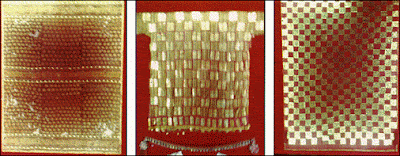
The actual mummified head of the crowned king in the photograph is almost twice as large as my own and I wear the largest hat of anyone in my acquaintance. When we were invited to the private gold museum to begin with I was expected to be dazzled by gold. However, it dawned on me the minute I walked through the door that the size of the head, and indeed his whole body, was the unique feature of this king. The gold was impressive, but the size of the man was something more impressive than gold.
The golden tunic that hung on the wall was made of spun gold. This was the first time in my life I had seen gold woven into a fabric for clothing. The tunic was over eight feet tall and tailored in such a way as to suggest that it was not intended to drag on the floor behind a king, but rather to hang straight down to the floor and no further. That made the tunic itself a measuring device for the original height of the giant king. It was shocking to imagine a man who could first wear this tunic without looking like a small child playing with his mother's clothing and secondly it was shocking to imagine the shear weight of the garment. The golden necklace at the foot of the tunic would have hung to the floor around the neck of anyone I know. The golden shoulder shield in the photograph was almost twice the size of shoulder pads used by professional football players.There was also a set of golden gloves whose hands and fingers extended from the wrist to the tip of the middle finger about twelve to fourteen inches. I couldn't tell exactly because they were kept behind security glass.
Nine-and-a-half feet tall is large for a human mummy, especially when it is found among today's diminutive Peruvians, whose average stature is just five feet. Understandably, professional anthropologists find tales of ancient giants amusing, but nothing more. Physical evidence may nonetheless exist to demonstrate that an oversized race of men did indeed dominate parts of prehistoric South America.

